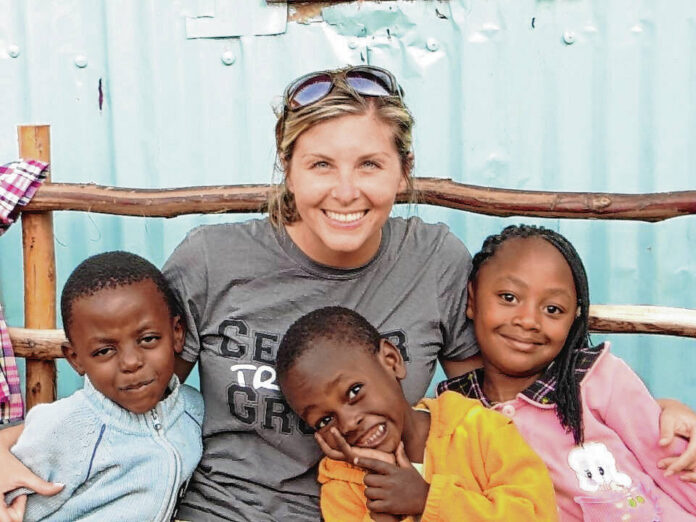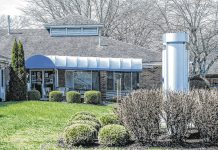
Photo provided Casey Voelz is shown on a previous Teacher Creativity Fellowship Program trip to visit Kenya and Tanzania for a project on water sustainability.
Three educators from the Bartholomew Consolidated School Corp. are receiving funds to pursue special trips.
Smith Elementary Principal Casey Voelz, Columbus East High School library media specialist Emily Cordova and Columbus North High School biology teacher Victoria Shireman have been awarded grants from the Lilly Endowment’s Teacher Creativity Fellowship Program.
According to Lilly, their project descriptions are as follows:
- “My Own Infinite Adventure” – Experience self-renewal while camping, exploring and journaling through the Alaskan wilderness (Cordova)
- “Restoration through Conservation” – Connect with nature and native cultures to learn and seek creative approaches to sustainability and conservation by traveling through Grand Teton, Yellowstone, and Glacier national parks and surrounding Native Reservations (Shireman)
- “The Triangle of Life: Embracing Life Habits in Thailand, Malaysia and Sri Lanka” – Explore and draw inspiration from the cultures of wellness in Thailand, Malaysia and Sri Lanka (Voelz)
The fellowship program was established in 1987 and provides Hoosier educators with grants of up to $12,000.
“The grants will fund renewal projects that the educators designed to help restore their commitment to the education profession and stimulate creativity, which promise to enhance the educational experiences of their students,” Lilly officials said.
More than 3,500 Indiana educators have been awarded fellowships since the program’s inception.
For Cordova, her trip will include traversing south central Alaska as part of an adventure travel group and participating in activities such as hiking, camping, observing wildlife, kayaking, ice climbing and white water rafting.
After 20 days with the travel group, Cordova will take a train ride, do some sightseeing in Fairbanks and participate in outdoors women’s skills camps with the Alaska Department of Fish and Game.
Since the company she plans to travel with is completely booked for this summer, Cordova will take her trip in 2024. She described it as a time to push herself physically in a real wilderness environment, as well as challenge herself mentally through self-reflection and journaling.
“I am a fairly recent empty nester and getting to a point in my career where retirement is just a little bit out of reach, so I feel like this will just kind of give me a perspective, renew, give me renewal, rejuvenate me,” she said. “I’m hoping through the self-reflection and the journaling I can bring things back here to my work life and the library here, building relationships with kids.”
Additionally, part of Cordova’s job as a library media specialist is to co-teach with other teachers at East, and she’s hoping that the experiences she gains from this trip will encourage teachers in disciplines besides just English to collaborate with her.
Shireman’s project will also feature a lot of time in the great outdoors, with her describing it as a “road/camping trip” through Wyoming and Montana. She and her husband will camp their way through Grand Teton National Park, Yellowstone National Park and Glacier National Park with stops in the Helena-Lewis and Clark National Forest, the Flathead National Forest, and the Blackfeet Reservation.
“As we make our way across the states we are going to be participating in native cultural activities, including some guided hikes and interpretive tours to learn more about the native tribes that inhabit the plains areas; their history, traditions, and practices; ideally learning about how native cultures have utilized the local flora and fauna throughout history as well as how they have sustainably utilized the other natural resources we have on our planet,” she said.
The trip will be about three weeks, and Shireman hopes to set out later this year.
She described her project application as a “bit of a moonshot proposal”, as she had never applied for a Lilly grant before and didn’t expect to receive one.
“I just imagined what a dream trip would be and then mapped it out to see if it would fit in the parameters of the grant,” said Shireman. “It did, so I just went for it!”
For Voelz, on the other hand, this will be her second trip through the Teacher Creativity Fellowship Program. She previously won a grant in 2012 and used the funds to visit Kenya and Tanzania for a project focused on water sustainability.
According to Voelz, educators can only win two Creativity Fellowships in their lifetime, so she will not be able to apply again.
Her latest fellowship project was inspired by a 2022 demographic study about life expectancy in different areas of Columbus. The study showed that Smith Elementary is located in an area where residents, on average, have a lifespan that is 17 years shorter.
Consequently, she decided to focus on implementing wellness initiatives at Smith, such as mindfulness, breathing techniques, sensory breaks and coping strategies for anger.
“There’s all kinds of research to say there’s physiological effects of stress and trauma on the brain and on wellness and kids’ overall health,” said Voelz. “And obviously, we have to have kids as healthy as we can in order to learn.”
In researching wellness, she looked at “Blue Zone” areas, which are renowned for having atypically high life expectancy rates. She also noticed that there are a lot of areas in southeast Asia that have the same life expectancy as the United States despite having lower GDPs and less access to resources.
Voelz plans to take her trip to Thailand, Malaysia and Sri Lanka over winter break, in order to avoid the rainy season. Her project to these will focus on embracing these countries’ “cultures of wellness.”
“Even within their schools, within their days, they have breathing techniques, they practice mindfulness, they have whole food eating and holistic healthcare and just some things that we can take away and try to bring back to our school to help our specific demographics just live a longer, healthier life,” she said. “And I think that starts with students. It starts with parents, it starts with community, but it also can be embraced in our school.”




